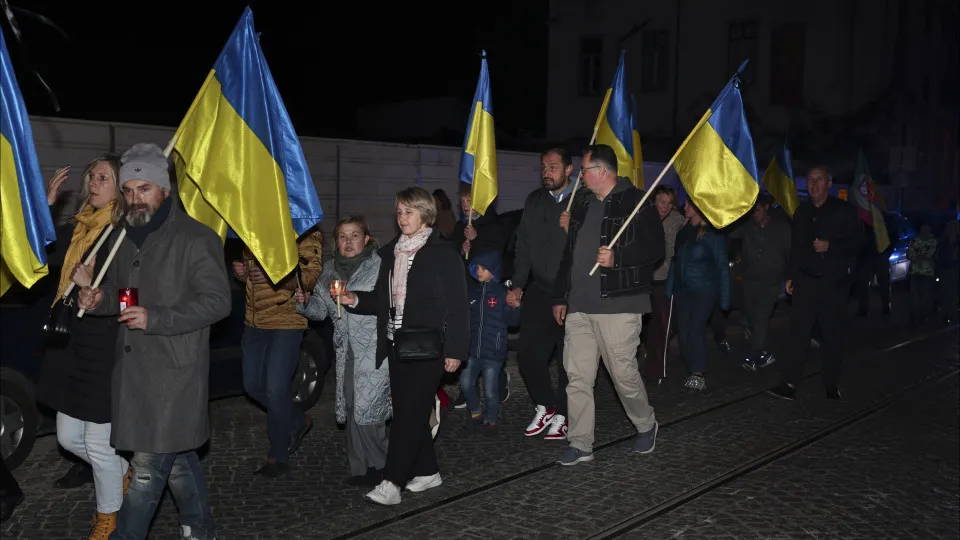
“During this whole period, Donald Trump claims to want to make peace and stop the war, but all we see is pressure on Ukraine and Ukrainians to surrender,” expressed Pavlo Sadokha in statements during the march in Lisbon marking Holodomor, the Russian genocide against Ukrainians, known as ‘The Great Famine’ in the 1930s.
He added, “What Trump proposes seems to have been proposed by the Russians, and now Trump wants to force Zelensky to sign or surrender. It is not a plan for peace, but a plan of catastrophe for Ukraine because nobody believes in Russia’s guarantees.” Sadokha noted, “We already had guarantees from Russia that were broken, and we continue with this war.”
About 50 Ukrainians gathered near Campo Mártires da Pátria in central Lisbon for a march to the Ukrainian Orthodox church, a few kilometers away, carrying several flags and candles to mark another year since the Holodomor when millions of Ukrainians died of starvation, primarily in the Donbass region.
“For 20 years, the Ukrainian community in Portugal and other countries of the world have gathered at this time to remember this terrible period,” said Sadokha, explaining that the objective was to annihilate the Ukrainians, especially in the region closest to Russia.
“The aim of the Great Famine, as we know from revealed documents and live testimonies collected by researchers, was to starve millions of Ukrainians, mainly in Donbass,” remarked the Ukrainian representative, adding that the current war is one of the consequences of that period.
“Ukrainians mainly died in Donbass, and then, in their place, Stalin transferred Russians and people of other nationalities to live there; today’s war is a consequence of the terrible Holodomor that happened there,” he lamented.
Questioned about Portugal’s support to Ukraine, Sadokha praised the “help even from the first day” and added: “Portugal is not a country with a large economy, but within its possibilities, and at least on political issues, always defends Ukraine and tries to gather Europe and other countries to help, which we are thankful for.”
For Irene Romanya, a participant, “Holodomor was genocide against Ukrainians, similar to what is happening now through war.”
Accompanied by her three small children, the protester considered participation in these events as “extremely important,” because “that’s how you pass the country’s history from parents to children and teach how the Holodomor affected the generations that followed the ones who suffered.”
The Ukrainian community is the second largest in Portugal, following the Brazilian one, with about one hundred thousand residents, more than half of whom are refugees.
Portugal formally recognized the existence of genocide in Ukraine in the 1930s in March 2017 when the Parliament approved a diploma in that regard.
The Holodomor, or death by starvation, between 1932 and 1933, is considered one of the largest extermination campaigns of the 20th century, frequently compared to the Holocaust, when the Soviet regime of Josef Stalin executed a plan of retaliation against Ukrainian peasants who refused land collectivization and were imposed with productivity quotas under penalty of losing food or even sanctions to entire regions.
The aim was to eliminate any resistance, especially among the ‘kulaks,’ lands of agricultural or livestock owners, and also to suppress any temptation of Ukrainian nationalism, both persecuted by the political police, which arrested, executed, or sent people to ‘gulags’ who were suspected.
“Stalin was aware of the famine the country was suffering at the beginning of the 1930s. However, he made a premeditated determination in 1932 to harden conditions in Ukraine, including blacklisting collective farms and villages, blocking the country’s borders so people couldn’t leave, and creating brigades that went house to house confiscating food from peasants,” said Anne Applebaum, an American journalist and historian naturalized Polish, in an interview with Spanish daily El Mundo. She is the author of “Red Famine,” a reference work on the Holodomor published in Portugal.
This was, therefore, not a famine caused by meteorological circumstances or a natural disaster, but one that followed a completely different pattern in Ukraine compared to other territories of the former Soviet Union, such as Russia or Kazakhstan—also affected—which explains, according to the author and Pulitzer Prize winner, the “disgusting, planned mortality.” From the most accepted number of nearly five million dead estimated, at least around 3.9 million were Ukrainian victims, mostly undernourished children, although other sources put these figures significantly higher.




